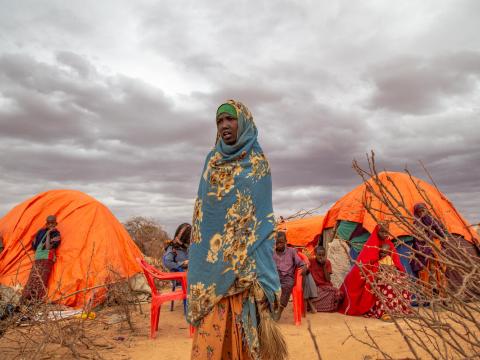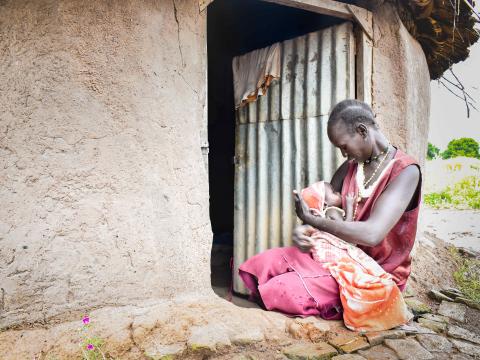
Priceless Losses: A call to help children affected by climate-induced loss and damage
As Mary Njeri, the Global Hunger Response director for World Vision International prepares for the upcoming UN climate meetings in Dubai (COP28), the story of Suldana, a 15-year-old climate refugee from Somalia, sticks in her mind.
Hungry and without water, she moved with her immediate family to a camp for internally displaced persons in Baidoa after five consecutive failed rainy seasons. She now works within the settlement doing household chores to raise money for her family. However, in the process, she misses out on schooling and faces harassment for simply being a girl. Due to hunger and the ongoing effects of climate change, Suldana does not benefit from the safeguards a child should expect from living with family or in an extended community.
As climate change and expanding conflicts have escalated the ongoing hunger crisis, millions of children are caught in unspeakable suffering. Many developing countries bear the largest burdens from the climate crisis while having produced the least greenhouse gases. Burdens like these are why the phrase “loss and damage” exists. It speaks to the unavoidable effects caused by climate change that occur with or without the involvement of mitigation or adaptation tactics. Often, this touches vulnerable communities around the world first and hardest.
As I have led World Vision's Global Hunger Response in 28 countries most affected by acute food insecurity and malnutrition, I regularly encounter children in these vulnerable areas like Suldana, who have lost their health, childhood, opportunities for education, family relationships, or even their lives due to hunger and environmental degradation caused by climate change.
I’m not the only one who has noticed this. Tejan, a young leader on climate from Sierra Leone, has spoken up as well. “Climate change affects children in every part of their lives – health, education, protection,’ said Tejan. “But we did not have anything to do with creating it.”
These remarks were also echoed by a Save the Children survey where an estimated 35% of children respondents are already campaigning or want to start campaigning to demand change. In fact, in the same survey, 73% of children respondents say adults should be doing more to tackle the issue.
As the planet’s changing climate undermines food security, disrupts ecosystems, and exacerbates extreme weather events, we see outcomes like prolonged droughts and severe floods. The truth is, until we act – and do so decisively – future generations hang in the balance.
In fact, the IPCC’s Sixth Assessment Report claims that future policies and actions taken will determine the severity on the world’s population. For example, the report suggests the number of people suffering from hunger in 2050 will range from 8 million to up to 80 million people.
Further, under a high vulnerability-high warming scenario, up to 183 million additional people are projected to become undernourished in low-income countries due to climate change by 2050. So, what’s our action plan?
At last year’s COP27 conference, the international community recognised the dire need to address climate-induced loss and damage, particularly as it relates to the most vulnerable – our children. During these discussions, the concept of the loss and damage fund emerged as a vital component of a much-needed global response. This fund is designed to provide financial support to the most vulnerable communities and individuals who suffer the harshest consequences of climate change, particularly children caught in the grip of hunger.
Earlier this month, countries on the transitional committee came to an agreement on key measures needed to provide funding to vulnerable countries. The World Bank would administer funds on an interim basis with the help of some developing countries as well as the E.U, the U.S., and the U.K. However, more discussions must happen at this year’s COP28 to make it a long-term reality. To me, it’s clear that these countries must commit to answering the hard questions on loss and damage fund management. They must also ensure it is flexible and fully accessible to the most vulnerable.
With quality funding commitments, we can ensure that children have access to basic needs and services as well as scaled-up, impactful approaches. This includes measures to enhance their resilience to the impacts of climate change, secure their access to food and clean water, and protect their right to an education.
By taking these actions, we can help children like Suldana regain their childhood, pursue an education, and build a brighter, more secure future, away from the devastating consequences caused by climate change, including hunger and malnutrition. It is clear to me – we have a collective responsibility to protect our most vulnerable. There is no time left to lose.
Mary Njeri is the award-winning director of the World Vision's Global Hunger Response. She has over a decade of experience in emergency food distribution, resource acquisition, refugee programming, and supporting communities prepare, mitigate, respond, and recover from natural disasters and conflict in Kenya and Northern Uganda.
Learn more about World Vision at COP28

